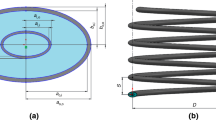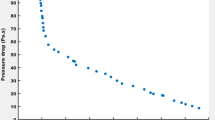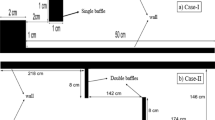Abstract
This optimization problem focuses to determine the five independent design variables to find out the optimal values of heat transfer coefficient (\(\stackrel{\sim }{H}\)) and pressure drop \((\Delta P)\) parameters. It consists of two conflicting optimization problem as discrete objective functions: first to maximize heat transfer coefficient and second to minimize pressure drop value. In this work, the problem is optimized using two approaches: First, single objective approach for both the objective functions separately to determine the optimal values of design variables using classical ALO and its modified variants. Secondly, multi-objective approach in which both the objective functions are optimized simultaneously to determine objective function values of heat transfer coefficient and pressure drop while optimizing design variables. This purpose is achieved using two different methods of multi-objective optimization: (i) Using weighted sum approach of multi-objective optimization using classical ALO and its proposed variants (ii) Pareto based multi-objective optimization using multi-objective antlion optimizer. The model used in this work is developed using Al2O3-water nanofluid using horizontal flat tube with the help of computational fluid dynamics and response surface methodology (RSM). The obtained results show superiority of ALO and its modified variants approach and also compared with RSM.




Similar content being viewed by others
References
Coello CC (2006) Evolutionary multi-objective optimization: a historical view of the field. IEEE Comput Intell Mag 1(1):28–36
Deb K, Pratap A, Agarwal S, Meyarivan TAMT (2002) A fast and elitist Multi-objective genetic algorithm: NSGA-II. IEEE Trans Evol Comput 6(2):182–197
Dinkar SK, Deep K (2017) Opposition based Laplacian ant lion optimizer. J.Comp Sci 23:71–90
Dinkar SK, Deep K (2018) An efficient opposition based Lévy Flight Antlion optimizer for optimization problems. J.Comp Sci 29:119–141
Dinkar SK, Deep K (2019a) Accelerated opposition-based antlion optimizer with application to order reduction of linear time-invariant systems. Arab J Sci Eng 44(3):2213–2241
Dinkar SK, Deep K (2019). Opposition-based antlion optimizer using Cauchy distribution and its application to data clustering problem. Neural Comp Appl 1–29
Dinkar SK, Deep K, Mirjalili S, Thapliyal S (2021) Opposition-based laplacian equilibrium optimizer with application in image segmentation using multilevel thresholding. Expert Syst Appl. https://doi.org/10.1016/j.eswa.2021.114766
Fogel DB, Michalewicz Z (2000) Evolutionary Computation 2, Advanced Algorithms and Operators.
Fonseca CM, Fleming PJ (1995) An overview of evolutionary algorithms in multi-objective optimization. Evol Comput 3(1):1–16
Holland JH, Goldberg D (1989) Genetic algorithms in search, optimization and machine learning. Addison-Wesley, Massachusetts
Laumanns M, Thiele L, Deb K, Zitzler E (2002) Combining convergence and diversity in evolutionary Multi-objective optimization. Evol Comput 10(3):263–282
Liang JJ, Qu BY, Suganthan PN (2013) Problem definitions and evaluation criteria for the CEC 2014 special session and competition on single objective real-parameter numerical optimization. Comp Intell Lab, Zhengzhou Univ, Zhengzhou China Tech Report, Nanyang Technol Uni, Singap 365:490
Lotfi R, Saboohi Y, Rashidi AM (2010) Numerical study of forced convective heat transfer of nanofluids: comparison of different approaches. Int Commun Heat Mass Transfer 37(1):74–78
Mirjalili S (2015) The ant lion optimizer. Adv Eng Softw 83:80–98
Mirjalili S, Jangir P, Saremi S (2017) Multi-objective ant lion optimizer: a multi-objective optimization algorithm for solving engineering problems. Appl Intell 46(1):79–95
Murshed SMS, Leong KC, Yang C (2009) A combined model for the effective thermal conductivity of nanofluids. Appl Therm Eng 29(11–12):2477–2483
Rahnamayan S, Tizhoosh HR, Salama MM (2006) Opposition versus randomness in soft computing techniques. Appl Soft Comput 8(2):906–918
Razi P, Akhavan-Behabadi MA, Saeedinia M (2011) Pressure drop and thermal characteristics of CuO–base oil nanofluid laminar flow in flattened tubes under constant heat flux. Int Commun Heat Mass Transfer 38(7):964–971
Safikhani H, Abbassi A, Khalkhali A, Kalteh M (2014) Multi-objective optimization of nanofluid flow in flat tubes using CFD, artificial neural networks and genetic algorithms. Adv Powder Technol 25(5):1608–1617
Safikhani H, Abbassi A, Khalkhali A, Kalteh M (2015) Modeling and optimization of nanofluid flow in flat tubes using a combination of CFD and response surface methodology. Heat Transf—As Res 44(4):377–395
Shariat M, Akbarinia A, Nezhad AH, Behzadmehr A, Laur R (2011) Numerical study of two phase laminar mixed convection nanofluid in elliptic ducts. Appl Therm Eng 31(14–15):2348–2359
Srinivas N, Deb K (1994) Muiltiobjective optimization using nondominated sorting in genetic algorithms. Evol Comput 2(3):221–248
Tesch K, Atherton MA, Karayiannis TG, Collins MW, Edwards P (2009) Determining heat transfer coefficients using evolutionary algorithms. Eng Optim 41(9):855–870
Tizhoosh HR (2005) Opposition-based learning: a new scheme for machine intelligence, In Computational intelligence for modelling, control and automation, 2005 and international conference on intelligent agents, web technologies and internet commerce, International Conference on (Vol. 1, pp. 695-701), IEEE.
Vajjha RS, Das DK, Namburu PK (2010) Numerical study of fluid dynamic and heat transfer performance of Al2O3 and CuO nanofluids in the flat tubes of a radiator. Int J Heat Fluid Flow 31(4):613–621
Yao X, Liu Y, Lin G (1999) Evolutionary programming made faster. IEEE Trans Evol Comput 3(2):82–102
Zhang L, Zhang N, Zhao F, Chen Y (2004) A genetic-algorithm-based experimental technique for determining heat transfer coefficient of exterior wall surface. Appl Therm Eng 24(2–3):339–349
Acknowledgements
The first author is thankful to All India Council of Technical Education (AICTE), Government of India.
Author information
Authors and Affiliations
Corresponding author
Ethics declarations
Conflict of interest
The authors declare that they have no conflict of interest.
Additional information
Publisher's Note
Springer Nature remains neutral with regard to jurisdictional claims in published maps and institutional affiliations.
Rights and permissions
About this article
Cite this article
Dinkar, S.K., Deep, K. Single and multi-objective optimization of nanofluid flow in flat tube to enhance heat transfer using antlion optimizer algorithms. Int J Syst Assur Eng Manag 12, 1026–1035 (2021). https://doi.org/10.1007/s13198-021-01091-1
Received:
Revised:
Accepted:
Published:
Issue Date:
DOI: https://doi.org/10.1007/s13198-021-01091-1




